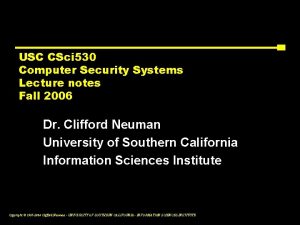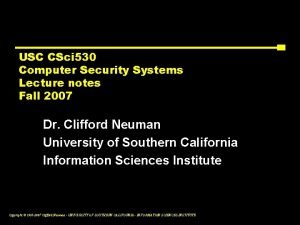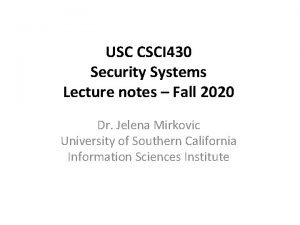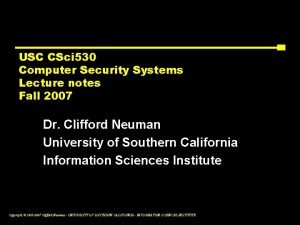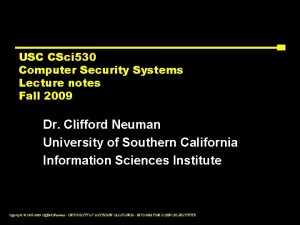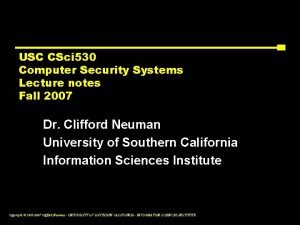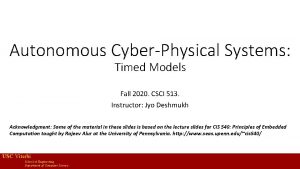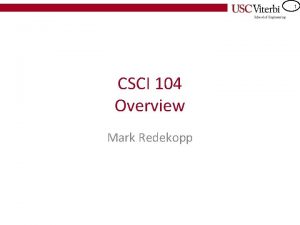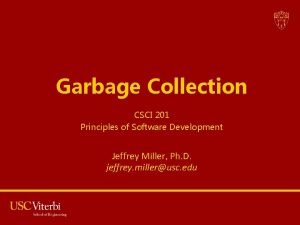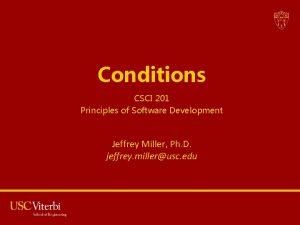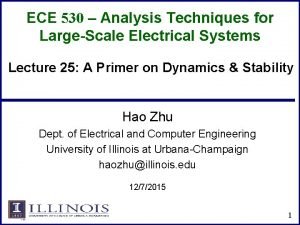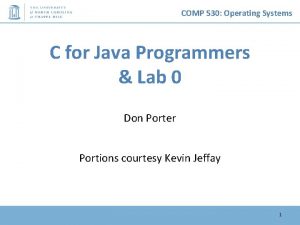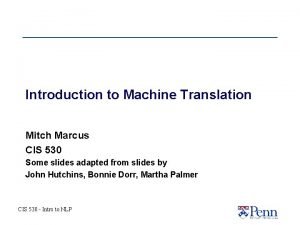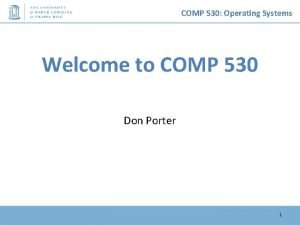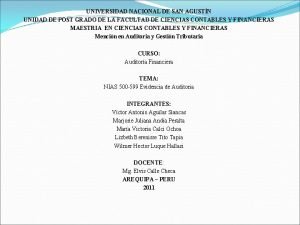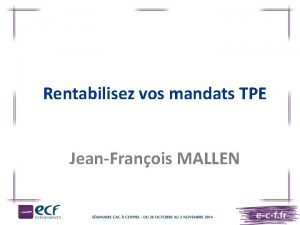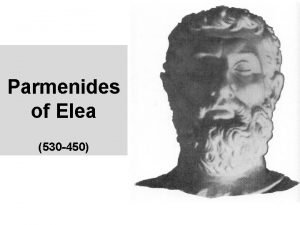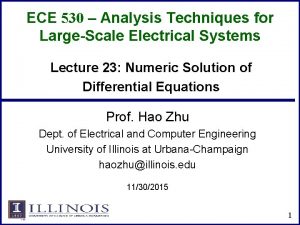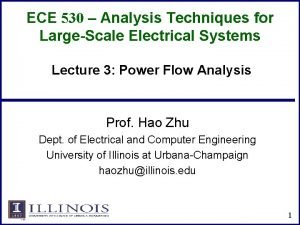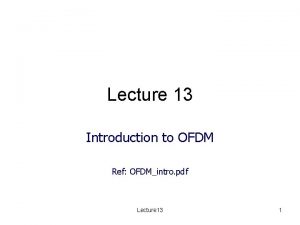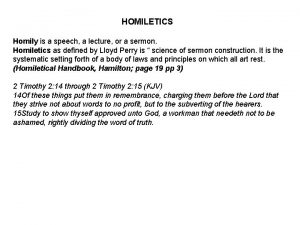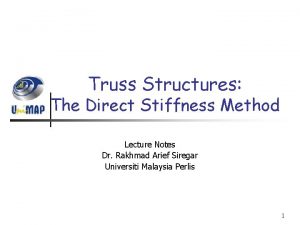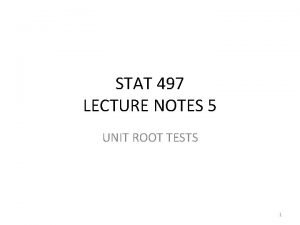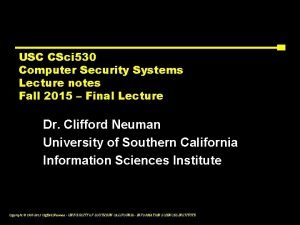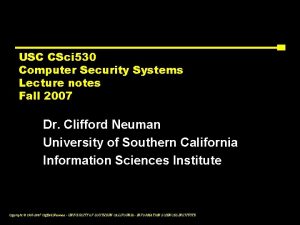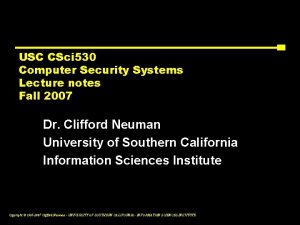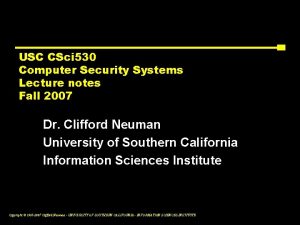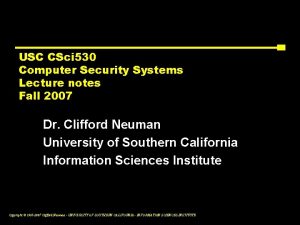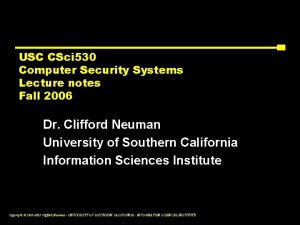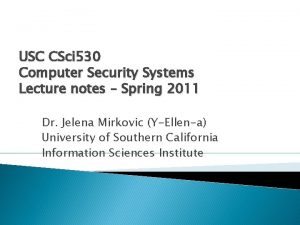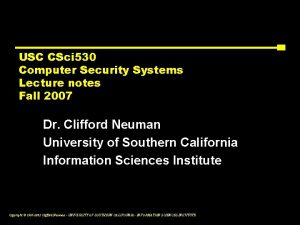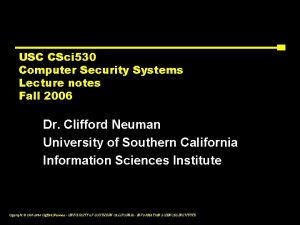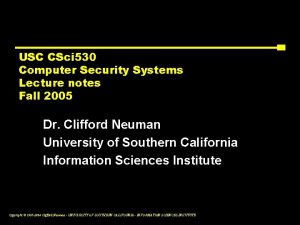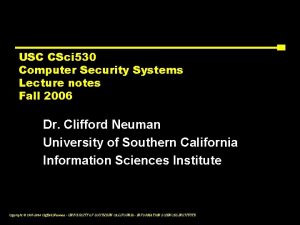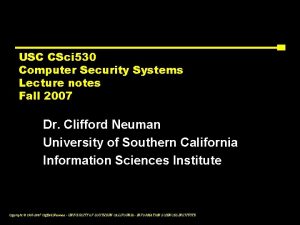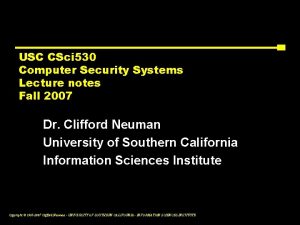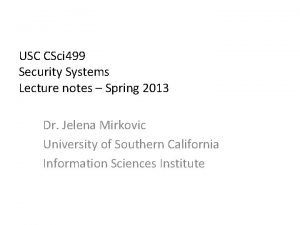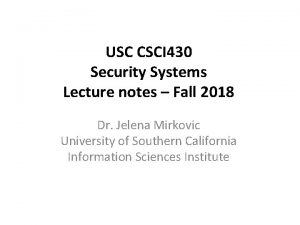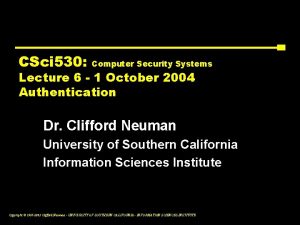USC CSci 530 Computer Security Systems Lecture notes















































![Solution #4 • Replace (or supplement) nonce in request/reply with timestamp [Denning, Sacco] – Solution #4 • Replace (or supplement) nonce in request/reply with timestamp [Denning, Sacco] –](https://slidetodoc.com/presentation_image_h2/3558be690972184c4dad04640ca6dd65/image-48.jpg)











- Slides: 59

USC CSci 530 Computer Security Systems Lecture notes Fall 2005 Dr. Clifford Neuman University of Southern California Information Sciences Institute Copyright © 1995 -2005 Clifford Neuman - UNIVERSITY OF SOUTHERN CALIFORNIA - INFORMATION SCIENCES INSTITUTE

CSci 530: Security Systems Lecture 3 – September 9, 2005 Cryptography (continued) Dr. Clifford Neuman University of Southern California Information Sciences Institute Copyright © 1995 -2005 Clifford Neuman - UNIVERSITY OF SOUTHERN CALIFORNIA - INFORMATION SCIENCES INSTITUTE

Administration http: //ccss. usc. edu/530 • Lab Section – Email is csci 530 L – New section added • D Clearances – 121+7 Enrolled, 26 on waiting list – Department will give clearances through 5 PM today If slots open. • Assignments on Web site (by Friday) Copyright © 1995 -2005 Clifford Neuman - UNIVERSITY OF SOUTHERN CALIFORNIA - INFORMATION SCIENCES INSTITUTE

Academic Integrity • I take Academic Integrity Seriously – Every year I have too many cases of cheating – Last year I assigned 3 F’s for the class • What is and is not OK – I encourage you to work with others to learn the material – Do not to turn in the work of others – Do not give others your work to use as their own – Do not plagiarize from others (published or not) – Do not try to deceive the instructors • See section on web site and assignments – More guidelines on academic integrity – Links to university resources Copyright © 1995 -2005 Clifford Neuman - UNIVERSITY OF SOUTHERN CALIFORNIA - INFORMATION SCIENCES INSTITUTE

FROM LAST LECTURE DES Modes of Operation – Electronic Code Book (ECB) Encrypt: Decrypt: x 1 xx 2 xn x e. K y 1 y 2 yn yy 1 y 2 yn d. K x 1 x 2 xn • Each block encrypted in isolation • Vulnerable to block replay Copyright © 1995 -2005 Clifford Neuman - UNIVERSITY OF SOUTHERN CALIFORNIA - INFORMATION SCIENCES INSTITUTE

DES Modes of Operation – Cipher Block Chaining (CBC) Encrypt: IV Decrypt: I V x 1 x 2 xn e. K y 1 y 2 yn yn d. K x 1 x 2 xn – Each plaintext block XOR’d with previous ciphertext – Easily incorporated into decryption – What if prefix is always the same? IV! Copyright © 1995 -2005 Clifford Neuman - UNIVERSITY OF SOUTHERN CALIFORNIA - INFORMATION SCIENCES INSTITUTE

DES Modes of Operation – Cipher Feedback Mode (CFB) Encrypt: x 1 e x x 2 e. K xxn e. K K Decrypt: IV y 1 y 2 yn e e. K K x 1 x 2 xn – For encrypting character-at-a-time (or less) – Chains as in CBC – Also needs an IV – Must be Unique – Why? Copyright © 1995 -2005 Clifford Neuman - UNIVERSITY OF SOUTHERN CALIFORNIA - INFORMATION SCIENCES INSTITUTE

DES Modes of Operation – Output Feedback Mode (OFB) xx 2 x 1 Encrypt: IV e e. K xxn e. K K Decrypt: IV y 1 y 2 yn e e. K K x 1 x 2 xn –Like CFB, but some bits of output fed back into input stream Copyright © 1995 -2005 Clifford Neuman - UNIVERSITY OF SOUTHERN CALIFORNIA - INFORMATION SCIENCES INSTITUTE

Variants and Applications • 3 DES: Encrypt using DES 3 x – Two and three-key types – Inner and outer-CBC modes ▪ Inner is more efficient, but less secure • Crypt: Unix hash function for passwords – Uses variable expansion permutations • DES with key-dependent S-boxes – Harder to analyze Copyright © 1995 -2005 Clifford Neuman - UNIVERSITY OF SOUTHERN CALIFORNIA - INFORMATION SCIENCES INSTITUTE

Lucifer Goes Standard • Generally regarded in 1970 s as one of the strongest cryptosystems • Heading toward standardization as DES – NSA managed to get key size reduced to 56 bits (from 112), yielding 1017 keys – Also apparently changed S-boxes – Why (or why not) do this? Copyright © 1995 -2005 Clifford Neuman - UNIVERSITY OF SOUTHERN CALIFORNIA - INFORMATION SCIENCES INSTITUTE

Certification of DES • Had to be recertified every ~5 years – 1983: Recertified routinely – 1987: Recertified after NSA tried to promote secret replacement algorithms ▪ Withdrawal would mean lack of protection ▪ Lots of systems then using DES – 1993: Recertified after continued lack of alternative Copyright © 1995 -2005 Clifford Neuman - UNIVERSITY OF SOUTHERN CALIFORNIA - INFORMATION SCIENCES INSTITUTE

Enter AES • 1998: NIST finally refuses to recertify DES – 1997: Call for candidates for Advanced Encryption Standard (AES) – Fifteen candidates whittled down to five – Criteria: Security, but also efficiency ▪ Compare Rijndael with Serpent – 2000: Rijndael selected as AES Copyright © 1995 -2005 Clifford Neuman - UNIVERSITY OF SOUTHERN CALIFORNIA - INFORMATION SCIENCES INSTITUTE

Structure of Rijndael • Unlike DES, operates on whole bytes for efficiency of software implementations • Key sizes: 128/192/256 bits • Variable rounds: 9/11/13 rounds • Rounds are not Feistel networks Copyright © 1995 -2005 Clifford Neuman - UNIVERSITY OF SOUTHERN CALIFORNIA - INFORMATION SCIENCES INSTITUTE

Structure of Rijndael • Round structure – Run block through S-box – Permute result into 4 x 4/4 x 6/4 x 8 array of bytes – Multiply each byte by 1, 2, or 3 in GF(28) – Mix subkey into result Copyright © 1995 -2005 Clifford Neuman - UNIVERSITY OF SOUTHERN CALIFORNIA - INFORMATION SCIENCES INSTITUTE

Security of Rijndael • Key size is enough • Immune to linear or differential analysis • But Rijndael is a very structured cipher – S-box consists of byte reciprocals in GF(28) – Permutations are regular • Attack on Rijndael’s algebraic structure – Breaking can be modeled as equations Copyright © 1995 -2005 Clifford Neuman - UNIVERSITY OF SOUTHERN CALIFORNIA - INFORMATION SCIENCES INSTITUTE

Impact of Attacks on Rijndael • Currently of theoretical interest only – Reduces complexity of attack to about 2100 – Also applicable to Serpent • Still, uncomfortably close to feasibility – DES is already insecure against brute force – Schneier (somewhat arbitrarily) sets limit at 280 • Certainly usable pending further results Copyright © 1995 -2005 Clifford Neuman - UNIVERSITY OF SOUTHERN CALIFORNIA - INFORMATION SCIENCES INSTITUTE

Public Key Cryptography • aka asymmetric cryptography • Based on some NP-complete problem – Unique factorization – Discrete logarithms ▪ For any b, n, y: Find x such that bx mod n = y • Modular arithmetic produces folding Copyright © 1995 -2005 Clifford Neuman - UNIVERSITY OF SOUTHERN CALIFORNIA - INFORMATION SCIENCES INSTITUTE

A Short Note on Primes • Why are public keys (and private keys) so large? • What is the probability that some large number p is prime? – About 1 in 1/ln(p) – When p ~ 2512, equals about 1 in 355 ▪ About 1 in 3552 numbers ~ 21024 is product of two primes (and therefore valid RSA modulo) Copyright © 1995 -2005 Clifford Neuman - UNIVERSITY OF SOUTHERN CALIFORNIA - INFORMATION SCIENCES INSTITUTE

RSA • Rivest, Shamir, Adleman • Generate two primes: p, q – Let n = pq – Choose e, a small number, relatively prime to (p-1)(q-1) – Choose d such that ed = 1 mod (p-1)(q-1) • Then, c = me mod n and m = cd mod n Copyright © 1995 -2005 Clifford Neuman - UNIVERSITY OF SOUTHERN CALIFORNIA - INFORMATION SCIENCES INSTITUTE

An Example • Let p = 5, q = 11, e = 3 – Then n = 55 – d = 27, since (3)(27) mod 40 = 1 • If m = 7, then c = 73 mod 55 = 343 mod 55 = 13 • Then m should = 1327 mod 55 Copyright © 1995 -2005 Clifford Neuman - UNIVERSITY OF SOUTHERN CALIFORNIA - INFORMATION SCIENCES INSTITUTE

An Example • Computing 1327 mod 55 – 131 mod 55 = 13, 132 mod 55 = 4, 134 mod 55 = 16, 138 mod 55 = 36, 1316 mod 55 = 31 – 1327 mod 55 = (13)(4)(36)(31) mod 55 = (1872 mod 55)(31) mod 55 = 62 mod 55 = 7 (check) Copyright © 1995 -2005 Clifford Neuman - UNIVERSITY OF SOUTHERN CALIFORNIA - INFORMATION SCIENCES INSTITUTE

Other Public Cryptosystems • El. Gamal (signature, encryption) – Choose a prime p, and two random numbers g, x < p – Public key is g, p, and y = gx mod p – Private key is x; to obtain from public key requires extracting discrete log – Mostly used for signatures Copyright © 1995 -2005 Clifford Neuman - UNIVERSITY OF SOUTHERN CALIFORNIA - INFORMATION SCIENCES INSTITUTE

Other Public Cryptosystems • Elliptic curve cryptosystems – y 2 = x 3 + ax 2 + bx + c – Continuous elliptic curves used in FLT proof – Discrete elliptic curves used to implement existing public-key systems ▪ Allow for shorter keys and greater efficiency Copyright © 1995 -2005 Clifford Neuman - UNIVERSITY OF SOUTHERN CALIFORNIA - INFORMATION SCIENCES INSTITUTE

Digital Signatures • Provides data integrity – Can it be done with symmetric systems? ▪ Verification requires shared key ▪ Doesn’t provide non-repudiation • Need proof of provenance – Hash the data, encrypt with private key – Verification uses public key to decrypt hash – Provides “non-repudiation” ▪ But what does non-repudiation really mean? Copyright © 1995 -2005 Clifford Neuman - UNIVERSITY OF SOUTHERN CALIFORNIA - INFORMATION SCIENCES INSTITUTE

Digital Signatures • RSA can be used • DSA: Digital Signature Algorithm – Variant of El. Gamal signature – Adopted as part of DSS by NIST in 1994 – Slower than RSA (but likely unimportant) – NSA had a hand in its design (? !) – Key size ranges from 512 to 1024 bits – Royalty-free Copyright © 1995 -2005 Clifford Neuman - UNIVERSITY OF SOUTHERN CALIFORNIA - INFORMATION SCIENCES INSTITUTE

Key Exchange • Diffie-Hellman key exchange – Choose large prime n, and generator g ▪ For any b in (1, n-1), there exists an a such that ga = b – Alice, Bob select secret values x, y, resp – Alice sends X = gx mod n – Bob sends Y = gy mod n – Both compute gxy mod n, a shared secret ▪ Can be used as keying material Copyright © 1995 -2005 Clifford Neuman - UNIVERSITY OF SOUTHERN CALIFORNIA - INFORMATION SCIENCES INSTITUTE

Hash Functions • Given m, compute H(m) • Should be… – Efficient: H() easy to compute – One-way: Given H(m), hard to find m’ such that H(m’) = H(m) – Collision-resistant: Hard to find m and m’ such that H(m’) = H(m) Copyright © 1995 -2005 Clifford Neuman - UNIVERSITY OF SOUTHERN CALIFORNIA - INFORMATION SCIENCES INSTITUTE

Use of Hashes in Signatures • Reduce input to fixed data size – MD 5 produces 128 bits – SHA 1 produces 160 bits • Encrypt the output using private key • Why do we need collisionresistance? Copyright © 1995 -2005 Clifford Neuman - UNIVERSITY OF SOUTHERN CALIFORNIA - INFORMATION SCIENCES INSTITUTE

Signing Using Only Hashes • • Generate random n 1, n 2, n 3, … Distribute H(n 1), H(n 2), H(n 3), … To authenticate message mi, release ni Problems – Seem to need 2128 or 2160 hashes to sign – Need to bootstrap signature • Resolvable? Copyright © 1995 -2005 Clifford Neuman - UNIVERSITY OF SOUTHERN CALIFORNIA - INFORMATION SCIENCES INSTITUTE

CSci 530: Security Systems Lecture 4 – September 16, 2005 Key Management Dr. Clifford Neuman University of Southern California Information Sciences Institute Copyright © 1995 -2005 Clifford Neuman - UNIVERSITY OF SOUTHERN CALIFORNIA - INFORMATION SCIENCES INSTITUTE

Cryptography in Use • Provides foundation for security services • But can it bootstrap itself? – Must establish shared key – Straightforward plan ▪ One side generates key ▪ Transmits key to other side ▪ But how? Copyright © 1995 -2005 Clifford Neuman - UNIVERSITY OF SOUTHERN CALIFORNIA - INFORMATION SCIENCES INSTITUTE

Security Through Obscurity? • Caesar ciphers – Very simple permutation – Only 25 different cases – Relies strictly on no one knowing the method Copyright © 1995 -2005 Clifford Neuman - UNIVERSITY OF SOUTHERN CALIFORNIA - INFORMATION SCIENCES INSTITUTE

Passwords • Reduces permutation space to key space • Caesar cipher: one-letter “key” • 10 -letter key for MSC reduces 26! (~4 x 1020) to 26 C 10 (~2 x 1013) 200 64 10 • 8 -byte key for DES reduces 2 ! (~10 ) to 256 (~1017) Copyright © 1995 -2005 Clifford Neuman - UNIVERSITY OF SOUTHERN CALIFORNIA - INFORMATION SCIENCES INSTITUTE

Two Problems • Peer-to-peer key sharing • Prob 1: Known peer, insecure channel • Prob 2: Secure channel, unknown peer Copyright © 1995 -2005 Clifford Neuman - UNIVERSITY OF SOUTHERN CALIFORNIA - INFORMATION SCIENCES INSTITUTE

Peer-to-Peer Distribution • Technically easy • But it doesn’t scale – Hundreds of servers… – Times thousands of users… – Yields ~ million keys • Centralized key server – Needham-Schroeder Copyright © 1995 -2005 Clifford Neuman - UNIVERSITY OF SOUTHERN CALIFORNIA - INFORMATION SCIENCES INSTITUTE

Using Cryptography • Touched upon one form of key exchange • Can cryptography bootstrap itself? – Must establish shared key – Straightforward plan ▪ One side generates key ▪ Transmits key to other side ▪ But how? Copyright © 1995 -2005 Clifford Neuman - UNIVERSITY OF SOUTHERN CALIFORNIA - INFORMATION SCIENCES INSTITUTE

Diffie Hellman • Choosing Generator for Diffie Hellman – Choose large prime p, and generator g ▪ For any b in (1, p-1), there exists an a such that ga = b ▪ This means that every number mod p can be written as a power of g (mod p). – One way to find such a g is to pick the p such that p = 2 q + 1 where q is also prime. – For such choices of p, half the numbers will be generators, and you can test if a candidate g is a generator by testing whether g^q (mod n) is equal to n-1. Copyright © 1995 -2005 Clifford Neuman - UNIVERSITY OF SOUTHERN CALIFORNIA - INFORMATION SCIENCES INSTITUTE

Man in the middle of DH • DH provides key exchange, but not authentication – You don’t really know you have a secure channel – Man in the middle – You exchange a key with eavesdropper, who exchanges key with the person you think you are talking to. – Eavesdropper relays all messages, but observes or changes them in transit. – Solutions: ▪ Published public values ▪ Authenticated DH (Sign or encrypt DH value) ▪ Encrypt the DH exchange ▪ Subsequently send has of DH value, with secret Copyright © 1995 -2005 Clifford Neuman - UNIVERSITY OF SOUTHERN CALIFORNIA - INFORMATION SCIENCES INSTITUTE

Peer-to-Peer Distribution • Technically easy – Each pair of users exchanges keys • But it doesn’t scale – Hundreds of servers… – Times thousands of users… – Yields ~ million keys Copyright © 1995 -2005 Clifford Neuman - UNIVERSITY OF SOUTHERN CALIFORNIA - INFORMATION SCIENCES INSTITUTE

KDC Based Key Distirbution • User sends request to KDC: {s} • KDC generates a random key: Kc, s – Encrypted twice: {Kc, s}Kc, {Kc, s}Ks – Typically called ticket and credentials, resp – Ticket forwarded with application request • No keys ever traverse net in the clear Copyright © 1995 -2005 Clifford Neuman - UNIVERSITY OF SOUTHERN CALIFORNIA - INFORMATION SCIENCES INSTITUTE

Problem #1 • How does user know session key is encrypted for the server? And vice versa? • Attacker intercepts initial request, and substitutes own name for server – Can now read all of user’s messages intended for server Copyright © 1995 -2005 Clifford Neuman - UNIVERSITY OF SOUTHERN CALIFORNIA - INFORMATION SCIENCES INSTITUTE

Solution #1 • Add names to ticket, credentials – Request looks like {c, s} – {Kc, s, s}Kc and {Kc, s, c}Ks, resp • Both sides can verify intended target for key sharing • This is basic Needham-Schroeder Copyright © 1995 -2005 Clifford Neuman - UNIVERSITY OF SOUTHERN CALIFORNIA - INFORMATION SCIENCES INSTITUTE

Problem #2 • How can user and server know that session key is fresh? • Attacker intercepts and records old KDC reply, then inserts this in response to future requests – Can now read all traffic between user and server Copyright © 1995 -2005 Clifford Neuman - UNIVERSITY OF SOUTHERN CALIFORNIA - INFORMATION SCIENCES INSTITUTE

Solution #2 • Add nonces to ticket, credentials – Request looks like {c, s, n} – {Kc, s, s, n}Kc and {Kc, s, c, n}Ks • Client can now check that reply made in response to current request Copyright © 1995 -2005 Clifford Neuman - UNIVERSITY OF SOUTHERN CALIFORNIA - INFORMATION SCIENCES INSTITUTE

Problem #3 • • User now trusts credentials But can server trust user? How can server tell this isn’t a replay? Legitimate user makes electronic payment to attacker; attacker replays message to get paid multiple times – Requires no knowledge of session key Copyright © 1995 -2005 Clifford Neuman - UNIVERSITY OF SOUTHERN CALIFORNIA - INFORMATION SCIENCES INSTITUTE

Solution #3 • Add challenge-response – Server generates second random nonce – Sends to client, encrypted in session key – Client must decrypt, decrement, encrypt • Effective, but adds second round of messages Copyright © 1995 -2005 Clifford Neuman - UNIVERSITY OF SOUTHERN CALIFORNIA - INFORMATION SCIENCES INSTITUTE

Problem #4 • What happens if attacker does get session key? – Answer: Can reuse old session key to answer challenge-response, generate new requests, etc Copyright © 1995 -2005 Clifford Neuman - UNIVERSITY OF SOUTHERN CALIFORNIA - INFORMATION SCIENCES INSTITUTE
![Solution 4 Replace or supplement nonce in requestreply with timestamp Denning Sacco Solution #4 • Replace (or supplement) nonce in request/reply with timestamp [Denning, Sacco] –](https://slidetodoc.com/presentation_image_h2/3558be690972184c4dad04640ca6dd65/image-48.jpg)
Solution #4 • Replace (or supplement) nonce in request/reply with timestamp [Denning, Sacco] – {Kc, s, s, n, t}Kc and {Kc, s, c, n, t}Ks, resp – Also send {t}Kc, s as authenticator ▪ Prevents replay without employing second round of messages as in challenge-response Copyright © 1995 -2005 Clifford Neuman - UNIVERSITY OF SOUTHERN CALIFORNIA - INFORMATION SCIENCES INSTITUTE

Problem #5 • Each client request yields new known-plaintext pairs • Attacker can sit on the network, harvest client request and KDC replies Copyright © 1995 -2005 Clifford Neuman - UNIVERSITY OF SOUTHERN CALIFORNIA - INFORMATION SCIENCES INSTITUTE

Solution #5 • Introduce Ticket Granting Server (TGS) – Daily ticket plus session keys – (How is this different from Enigma? !) • TGS+AS = KDC – This is modified Needham-Schroeder – Basis for Kerberos Copyright © 1995 -2005 Clifford Neuman - UNIVERSITY OF SOUTHERN CALIFORNIA - INFORMATION SCIENCES INSTITUTE

Problem #6 • Active attacker can obtain arbitrary numbers of known-plaintext pairs – Can then mount dictionary attack at leisure – Exacerbated by bad password selection Copyright © 1995 -2005 Clifford Neuman - UNIVERSITY OF SOUTHERN CALIFORNIA - INFORMATION SCIENCES INSTITUTE

Solution #6 • Preauthentication – Establish weak authentication for user before KDC replies – Examples ▪ Password-encrypted timestamp ▪ Hardware authentication ▪ Single-use key Copyright © 1995 -2005 Clifford Neuman - UNIVERSITY OF SOUTHERN CALIFORNIA - INFORMATION SCIENCES INSTITUTE

Public Key Distribution • Public key can be public! – How does either side know who and what the key is for? Private agreement? (Not scalable. ) – Chosen plaintext • Must delegate certification – Why? – How? Copyright © 1995 -2005 Clifford Neuman - UNIVERSITY OF SOUTHERN CALIFORNIA - INFORMATION SCIENCES INSTITUTE

Certification Infrastructures • Public keys represented by certificates • Certificates signed by other certificates – User delegates trust to trusted certificates – Certificate chains transfer trust up several links Copyright © 1995 -2005 Clifford Neuman - UNIVERSITY OF SOUTHERN CALIFORNIA - INFORMATION SCIENCES INSTITUTE

Examples • PGP – “Web of Trust” – Can model as connected digraph of signers • X. 500 – Hierarchical model: tree (or DAG? ) – (But X. 509 certificates use ASN. 1! Copyright © 1995 -2005 Clifford Neuman - UNIVERSITY OF SOUTHERN CALIFORNIA - INFORMATION SCIENCES INSTITUTE

Examples • SSH – User keys - out of band exchange. – Weak assurance of server keys. ▪ Was the same host you spoke with last time. – Discussion of benefits Copyright © 1995 -2005 Clifford Neuman - UNIVERSITY OF SOUTHERN CALIFORNIA - INFORMATION SCIENCES INSTITUTE

What to do with keys • Practical issues – How to carry them ▪ Passwords vs. disks vs. smartcards – Where do they stay, where do they go – How many do you have – How do you get them to begin with. Copyright © 1995 -2005 Clifford Neuman - UNIVERSITY OF SOUTHERN CALIFORNIA - INFORMATION SCIENCES INSTITUTE

Key Distribution linked to Authentication • Its all about knowing who has the keys. • We will revisit Kerberos when we discuss authentication. Copyright © 1995 -2005 Clifford Neuman - UNIVERSITY OF SOUTHERN CALIFORNIA - INFORMATION SCIENCES INSTITUTE

Current Event Cryptography flaw shoots down traffic conviction Declan Mc. Cullagh and Alex Coby, 12 August 2005 uk. builder. com Flaws in the MD 5 hashing algorithm have thrown every Australian speeding conviction that relied on camera data into doubt Suspected flaws in a computer algorithm have invalidated a fine issued by a speed camera in Australia, and cast thousands more into doubt. A Sydney magistrate tossed out a speeding ticket after the Roads and Traffic Authority (RTA), a government agency, failed to prove in court that the MD 5 algorithm was cryptographically sound, despite being given eight weeks to do so. The problem lay with suspected flaws in the hashing algorithm that had previously been relied upon to prove image authenticity, as it is used to encode the time and date of alleged speeding incidents, as well as details of the car in question. Copyright © 1995 -2005 Clifford Neuman - UNIVERSITY OF SOUTHERN CALIFORNIA - INFORMATION SCIENCES INSTITUTE
 Csci 530 security systems
Csci 530 security systems Netcheque
Netcheque Csci430
Csci430 Csci 530 usc
Csci 530 usc Pinstir
Pinstir Csci 530
Csci 530 Csci 513
Csci 513 Csci 104 usc
Csci 104 usc 201 principles of software development
201 principles of software development Csci201
Csci201 01:640:244 lecture notes - lecture 15: plat, idah, farad
01:640:244 lecture notes - lecture 15: plat, idah, farad Operating systems lecture notes
Operating systems lecture notes Computer aided drug design lecture notes
Computer aided drug design lecture notes Computer architecture lecture notes
Computer architecture lecture notes Computer security 161 cryptocurrency lecture
Computer security 161 cryptocurrency lecture Private securit
Private securit Ece 530
Ece 530 Comp 530
Comp 530 Bioc 530
Bioc 530 Cis 530
Cis 530 Comp 530
Comp 530 Nia 500 evidencia de auditoría
Nia 500 evidencia de auditoría Nep 630
Nep 630 Principle of non contradiction
Principle of non contradiction Ece 530
Ece 530 Ece 530
Ece 530 Ar 530-1
Ar 530-1 Project procurement management lecture notes
Project procurement management lecture notes Theology proper lecture notes
Theology proper lecture notes Public sector accounting pdf notes
Public sector accounting pdf notes Project management lecture
Project management lecture Electricity and magnetism lecture notes
Electricity and magnetism lecture notes Classical mechanics
Classical mechanics Physical science lecture notes
Physical science lecture notes Power system dynamics and stability lecture notes
Power system dynamics and stability lecture notes Microbial physiology lecture notes
Microbial physiology lecture notes Application of mechatronics ppt
Application of mechatronics ppt Limits fits and tolerances lecture notes
Limits fits and tolerances lecture notes Financial engineering notes
Financial engineering notes Bjt lecture notes
Bjt lecture notes Software engineering lecture notes
Software engineering lecture notes Introduction to ofdm
Introduction to ofdm Land use planning '' lecture notes
Land use planning '' lecture notes Project quality management lecture notes
Project quality management lecture notes Lecture notes on homiletics
Lecture notes on homiletics Foundation engineering lecture notes
Foundation engineering lecture notes Image processing lecture notes
Image processing lecture notes Intermediate microeconomics lecture notes
Intermediate microeconomics lecture notes Cloud computing lecture
Cloud computing lecture Decision theory lecture notes
Decision theory lecture notes Polynomial regression least squares
Polynomial regression least squares Advanced inorganic chemistry lecture notes
Advanced inorganic chemistry lecture notes Fundamental deviation table
Fundamental deviation table Global stiffness matrix
Global stiffness matrix Reservoir and channel routing
Reservoir and channel routing Adf.test in r
Adf.test in r Shape memory alloys lecture notes
Shape memory alloys lecture notes Research method notes
Research method notes Financial markets and institutions ppt
Financial markets and institutions ppt Physics 101 lecture
Physics 101 lecture
